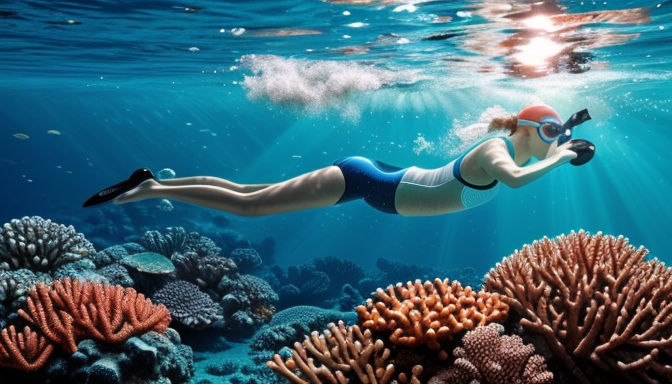Are you tired of feeling exhausted after a swim? It’s time to swim smarter, not harder! Whether you’re just starting out or looking to refine your skills, mastering the four main strokes—freestyle, backstroke, breaststroke, and butterfly—can significantly enhance your performance in the water. Each stroke has its unique nuances, and understanding these can make a world of difference.
Let’s dive into the details! Freestyle is all about efficiency; focus on your body position and streamline your movements. A common mistake is overreaching with the arms, which can lead to unnecessary drag. Instead, think of your arms as oars in a boat—smooth, rhythmic, and synchronized with your breathing. Backstroke requires a relaxed grip and a steady kick. Picture yourself floating on your back, allowing the water to support you while you glide effortlessly.
Now, when it comes to breaststroke, timing is everything. Perform the pull, breathe, and kick in a fluid motion, almost like a dance. As for the butterfly, it’s all about rhythm and power. Use your core to drive the motion, and remember, it’s not just about strength; it’s about technique. Want to get better? Look for in-depth guides tailored for each stroke that cater to all skill levels. With practice and the right techniques, you’ll find yourself swimming longer distances with less fatigue and more enjoyment!
Efficient Stroke Techniques
When it comes to swimming, mastering your strokes is like finding the perfect rhythm in a song; it can transform your performance from ordinary to extraordinary. Freestyle, backstroke, breaststroke, and butterfly are not just strokes; they are techniques that, when executed correctly, can lead to remarkable efficiency in the water. Imagine gliding effortlessly, conserving energy while others are struggling to keep pace. Sounds appealing, right?
Let’s dive into the details! For freestyle, focus on your body position. Keep your head low and your hips high. This alignment minimizes drag and maximizes speed. Similarly, in backstroke, maintaining a streamlined position while rotating your body helps in achieving a fluid motion. Remember, it’s not just about moving your arms; it’s about creating a harmonious flow through the water.
Now, for those who adore the classic breaststroke, think of it as a graceful dance. Your arms and legs should work in unison, pushing the water back while your body glides forward. Lastly, the butterfly stroke, often seen as the most challenging, requires rhythm and timing. Picture a dolphin swimming through the ocean; that’s the kind of fluidity you should aim for!
Incorporating these techniques into your practice can dramatically enhance your swimming experience. By focusing on efficiency, you’ll find that swimming longer distances becomes less of a chore and more of a joy. So, are you ready to swim smarter, not harder?

Breathing Strategies
When it comes to swimming, breathing is often the unsung hero of performance. Mastering the art of breathing can transform your swim from a struggle to a smooth glide through the water. So, how do you breathe effectively? First, let’s talk about the rhythm. Just like a musician needs a beat, you need a consistent breathing pattern to keep your strokes efficient. Imagine your breath as the fuel to your engine; without it, you’re not going far!
For those mastering different strokes, each has its own unique breathing technique:
- Freestyle: Breathe every two to three strokes, turning your head to the side. This helps maintain a streamlined position.
- Backstroke: Keep your face up and breathe continuously; it’s like taking a breath of fresh air while lying on a sunny beach!
- Breaststroke: Inhale quickly as your arms pull back, and exhale when your head goes underwater. Think of it as a synchronized dance.
- Butterfly: Take a breath every one or two strokes, timing it with the peak of your stroke, like catching a wave at just the right moment.
Mastering these techniques not only enhances oxygen intake but also boosts your endurance. By incorporating breathing drills into your practice, you’ll feel more relaxed and focused. Remember, swimming isn’t just about strength; it’s about efficiency and control. So, next time you’re in the pool, pay attention to your breath—it could be the game changer you’ve been looking for!
Frequently Asked Questions
- What are some effective stroke techniques for beginners?
For beginners, focusing on a streamlined body position, proper arm movement, and a consistent kick can make a world of difference. Think of it like riding a bike; once you get the balance right, everything else falls into place!
- How can I improve my breathing while swimming?
Improving your breathing technique is all about rhythm and timing. Try practicing bilateral breathing to keep your stroke balanced. Imagine you’re a fish gliding through water—smooth and effortless!
- Is it better to swim faster or more efficiently?
Efficiency is key! Swimming faster might seem impressive, but if you’re expending too much energy, you’ll tire out quickly. It’s like sprinting versus jogging; pace yourself for the long haul!
- How often should I practice these techniques?
Consistency is crucial! Aim to practice at least 3-4 times a week. Just like any skill, the more you swim, the better you’ll get. Think of it as building a muscle; regular workouts lead to growth!
- Can these techniques help competitive swimmers?
Absolutely! Competitive swimmers can benefit immensely from refining their techniques. Even small adjustments can lead to significant improvements in speed and performance. It’s all about the details!